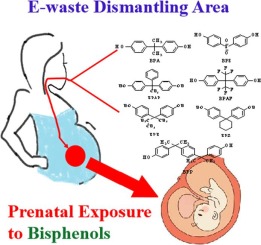当前位置:
X-MOL 学术
›
Environ. Int.
›
论文详情
Our official English website, www.x-mol.net, welcomes your
feedback! (Note: you will need to create a separate account there.)
Concentrations of bisphenol A and its alternatives in paired maternal-fetal urine, serum and amniotic fluid from an e-waste dismantling area in China.
Environment International ( IF 10.3 ) Pub Date : 2020-01-16 , DOI: 10.1016/j.envint.2019.105407 Bo Zhang 1 , Yuan He 1 , Hongkai Zhu 2 , Xiongfei Huang 1 , Xueyuan Bai 1 , Kurunthachalam Kannan 2 , Tao Zhang 1
Environment International ( IF 10.3 ) Pub Date : 2020-01-16 , DOI: 10.1016/j.envint.2019.105407 Bo Zhang 1 , Yuan He 1 , Hongkai Zhu 2 , Xiongfei Huang 1 , Xueyuan Bai 1 , Kurunthachalam Kannan 2 , Tao Zhang 1
Affiliation

|
Bisphenol A (BPA) and its alternatives are suspected endocrine disruptors. However, prenatal exposure and transplacental transfer of bisphenols (BPs is still limited. Therefore, BPA and its six alternatives in maternal serum (MS), maternal urine (MU), cord serum (CS), and amniotic fluid (AF) samples collected from 106 maternal-fetal pairs in an e-waste dismantling site in Southern China were determined. Bisphenol AF (BPAF) and bisphenol S (BPS) were the dominant BPA alternatives observed in MS and CS, and the geometric mean (GM) concentration of BPAF (0.013 ng/mL in MS, 0.097 ng/mL in CS) and BPS (0.01 ng/mL in MS, 0.03 ng/mL in CS) in MS and CS was lower than that of BPA (0.5 ng/mL in MS, 1.2 ng/mL in CS). The ratios of BPA concentrations between MU and MS (MU:MS ratio) were over three times higher than those of AF and CS (AF:CS ratio), thereby suggesting low biotransformation/metabolism of BPA in fetuses. The placental transfer rates of BPs (i.e., CS:MS ratio) were compound-specific (BPAF 3.26, BPA 1.94, BPS 1.11). Results suggest that BPA and its alternatives can pass through the placental barrier. The placental transfer rates of BPs are positively related to molecular weight or log Kow values. This finding indicates that an active transport is responsible for the placental transfer of BPs.
更新日期:2020-01-17











































 京公网安备 11010802027423号
京公网安备 11010802027423号